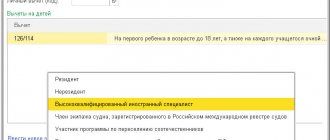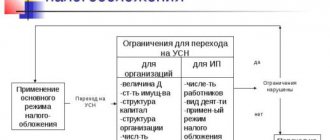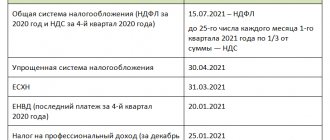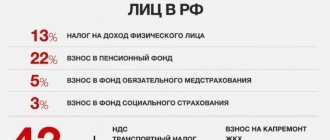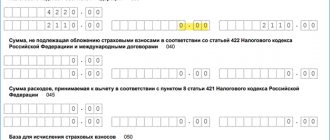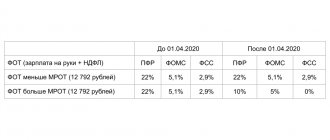Home • Blog • Blog for entrepreneurs • What taxes does an individual entrepreneur pay on the simplified tax system?
November 19, 2021
861
Taxes for individual entrepreneurs under the simplified tax system are somewhat different from contributions from entrepreneurs under other taxation systems. The taxpayer receives a low interest rate, simple reporting, and the opportunity to reduce taxes through insurance payments.
“Simplified” is aimed at representatives of small and medium-sized businesses. This regime is especially popular among individual entrepreneurs without employees - with a small income, the tax can be reduced to almost zero. The simplified tax system is regulated by Chapter 26.2 of the Tax Code of the Russian Federation.
Features of the simplified tax system
Taxpayers under the simplified tax regime are recognized as both individual entrepreneurs and organizations. To switch to this tax regime, you need to meet certain requirements.
General terms
- number of employees less than 100 people;
- the activity is not related to the production of excisable goods - with the exception of wines, wine materials and other products made from its own raw materials;
- there is no work on the extraction and sale of minerals;
- annual income does not exceed 150 million rubles.
Additionally, conditions are provided for organizations. To be more precise, selection for “simplified” jobs is carried out based on the number of employees, type of activity and annual profitability.
Particular attention should be paid to the fact that from 01/01/2021, serious changes will come into force regarding the limits for individual entrepreneurs and LLCs, giving the right to operate on the simplified tax system (Federal Law No. 266 of 07/31/2020). Let's take a closer look at them.
Does individual entrepreneur pay personal income tax?
An individual entrepreneur is recognized as an individual who carries out entrepreneurial activities. As is known from the norms of Ch. 23 of the Tax Code of the Russian Federation, payers of income tax are individuals who receive income. Thus, at first glance, an individual entrepreneur must pay personal income tax to the budget. However, due to the fact that the implementation of entrepreneurial activities by an individual has a number of nuances, it is necessary to clearly answer the question: “Does an entrepreneur of this status pay personal income tax or not and is a 3-NDFL certificate needed for an individual entrepreneur?” - will not work.
In order to understand when an individual entrepreneur still faces such an obligation, we suggest first considering some questions:
- Is the individual entrepreneur on simplified, imputed and other special modes, or does he work on OSNO?
To learn how the business regime chosen by an individual entrepreneur affects the occurrence of the obligation to pay personal income tax, as well as the pros and cons of each mode, read the article “Taxation regimes for individual entrepreneurs - what to apply?” .
- Does the income received by an individual entrepreneur fall under the list of income from his main activities?
The answer to this question also affects the fact of paying personal income tax. For example, if a simplified individual entrepreneur received income from performing work that was not stated in the constituent documents, this is one situation. And it’s a completely different matter if a simplified individual entrepreneur received income from his business activities.
- Does the individual entrepreneur have hired employees?
Having a staff of hired workers under his command, the individual entrepreneur becomes a tax agent for withholding personal income tax.
You can get acquainted with comprehensive answers to the above questions, as well as find out what other income triggers the payment of personal income tax, in the material “Should an individual entrepreneur pay personal income tax (cases and nuances)?” .
Limits on the simplified tax system in 2022
In 2022, two sets of limits for the simplified tax system will come into effect:
- basic, familiar to entrepreneurs;
- elevated.
Compliance with the basic limits gives the right to individual entrepreneurs using the simplified tax system to pay tax at standard rates, as in 2022. Higher limits require you to make payments at higher rates.
| Limit | Base | Elevated |
| Annual income, in rubles | 150 million | 200 million |
| Number of employees, people | 100 | 130 |
Checking for compliance with limits is carried out in the usual form:
- income is calculated throughout the year (results are summed up at the end of each quarter);
- The number of employees for each reporting period is calculated.
The obtained values are compared with acceptable values. If they exceed the basic limits, it is worth moving to another level. If the data exceeds even the increased limit, the simplified tax system will have to be abandoned and switched to the general taxation regime.
Tax calculation for simplified tax system
There are two objects of taxation on the simplified tax system:
- “Income” - 6% of “dirty” profit;
- “Income minus expenses” - 15% (“net” profit).
Individual entrepreneurs have the right to choose any scheme that is beneficial in their opinion. It must be indicated once a year. It will be possible to change the object of taxation only after the end of the annual period.
Note! Participants in a simple partnership agreement or trust management of property can calculate tax only on “net” profit.
For individual entrepreneurs working under the “Income minus expenses” scheme, a “minimum tax” is provided. It is 1% of the tax base calculated under the “Income” object. If, at the end of the reporting period, the entrepreneur’s tax amount is less than the minimum, he will have to pay 1% of the “dirty” income.
Example. Net profit for the reporting period amounted to 400,000 rubles, and together with expenses - 2 million rubles. The tax is calculated as follows: 400,000 * 15% = 60,000 rubles. At the same time, the minimum tax is calculated: 2,000,000 * 1% = 20,000 rubles. The amount to be paid is 60 thousand rubles, so it is higher.
| Read and ask questions: Tax holidays for individual entrepreneurs in 2022 |
Tax rates under the simplified tax system in 2022
Let us remind you that individual entrepreneurs using the simplified tax system in 2022 pay income tax according to the standard limit. With another limit coming into effect in 2022, some businesses will face higher rates.
The table clearly shows the tax rates that begin to apply from 01/01/2021.
| Object of taxation | Tariff with basic limits | Tax rate at higher limits |
| "Income" | 6% | 8% |
| "Income minus expenses" | 15% | 20% |
Preferential rates
Tax benefits for individual entrepreneurs using the simplified tax system are provided for certain categories of taxpayers:
- from 1 to 6% - “Income”;
- from 5 to 15% - from “net” profit.
How to reduce individual entrepreneur taxes on the simplified tax system? The decision to apply preferential rates is made at the local level. In particular, they operate in Crimea. Between 2022 and 2022, the rate could be reduced to 3% when calculating tax on “net” income. It is established depending on the type of activity and category of the entrepreneur.
For taxpayers registered for the first time, a tax rate of 0% can be set for two tax periods. This applies to manufacturers, categories operating in the scientific or social spheres, in the field of providing household services to the population and places for temporary residence. The share of income from the sale of goods must exceed 70% of the total profit.
When using a 0% rate, certain restrictions may be imposed on individual entrepreneurs:
- on the number of employees;
- to the maximum amount of profit from sales (reduced by no more than 10 times).
In each region, the rate is considered individually. As a rule, preferential tax payments are established for certain types of activities that require enhanced development in a particular area.
Deadlines
The tax period under the simplified tax system is a year.
Reporting periods: first quarter, half year, 9 months. Based on the results of the tax period, entrepreneurs submit a declaration to the tax service. Individual entrepreneurs must meet the deadline by April 30 of the year following the expired tax period.
Entrepreneurs make advance payments throughout the year. Deadlines for paying individual entrepreneur taxes on the simplified tax system in the form of advance payments:
- until 25.04. for the first quarter;
- until 25.07. For half a year;
- until 25.10. in 9 months
Advance payments made during the year are taken into account when calculating the annual tax. The tax amount can be reduced by paying insurance premiums.
Note! Due to the spread of coronavirus infection, the Government has decided to extend the deadlines for submitting declarations and paying taxes. More details in the summary table.
Simplified tax system with tax object “Income”
During the year, you need to make three advance payments: before April 25, July and October.
How to calculate them?
You need to take the amount of income from KUDiR for the first three months and multiply it by the rate. You will receive an advance for the first quarter, which must be paid to the budget.
If in the first quarter you managed to pay part of the insurance premiums for yourself or for your employees, and also paid them sick leave, then you can reduce the advance by this amount.
Businessmen without employees can reduce the advance completely, down to zero, employers - only by half.
If an entrepreneur pays a trade tax, then the tax can also be reduced on it, and there are no restrictions of 50% for employers - they can also reduce it down to zero.
Example of calculation for an entrepreneur without employees (in rubles):
Businessman Petrov for the first quarter. earned 200 thousand.
The rate is 6%.
In February, Petrov paid part of the contributions for himself in the amount of 10 thousand.
200 x 6% = 12 thousand rubles. From them we subtract 10 thousand insurance payments and get 2 thousand, which Petrov must pay by April 25.
Example for an entrepreneur with employees:
Income of IP Sidorov for the first quarter. – 350 thousand
The rate is 6%.
During the first quarter, Sidorov paid insurance premiums for himself and his employees in the amount of 30 thousand.
350 x 6% = 21 thousand. Employers can only reduce the tax by half, so we do not deduct insurance payments in full, but only 10.5 thousand.
There are 10.5 thousand left to be paid by April 25th.
At the end of the second quarter, you will need to take the revenue for 6 months on an accrual basis and multiply it by the rate. We will receive an advance for the first half of the year.
From it you will need to subtract what you have already paid for the first quarter. and the amount of insurance payments for yourself and employees (and the amount of the trade fee, if any).
We will receive an advance payment for the first half of the year.
Calculation for individual entrepreneurs without an employee:
The same Petrov earned 500 thousand in six months.
The rate is 6%.
Over the course of six months, Petrov paid 20 thousand in insurance premiums for himself.
500 thousand x 6% = 30 thousand. From them we subtract 20 thousand insurance contributions and 10 advance payment, which has already been paid for the first quarter, and find out that Petrov does not need to pay anything for the six months: 30 – 20 – 10 = 0
Calculation for individual entrepreneurs with employees:
Sidorov, as we know him, earned exactly a million in the first half of the year.
The rate is 6%.
Within 6 months, Sidorov paid contributions for himself and his employees in the amount of 70 thousand.
1 million x 6% = 60 thousand. We reduce the tax by half and get 30 thousand - an advance payment for the 1st half of the year, which must be transferred before July 25.
An advance for 9 months is calculated according to the same principle - income is taken on an accrual basis and reduced by the amount of advances and insurance contributions already paid (and sales tax, if any).
In the same way, you will need to calculate the total amount of individual entrepreneur tax on the simplified tax system per year and receive the amount either for additional payment until April 30, or for reduction.
Additional insurance premiums paid by those who earn more than three hundred thousand can be deducted from advance payments. Provided that these contributions have already been transferred to the budget.
In this case, there is also a restriction for employers - the tax is reduced by no more than 50%.
Additional contributions can begin to be paid in installments as soon as revenue exceeds 300,000, or in one payment until July 1 of the next year.
In which period you transfer the additional contribution, in the same period you will be able to reduce the tax, not earlier.
Insurance premiums
The amounts of taxes and contributions of individual entrepreneurs to the simplified tax system depend on the number of employees and profit.
The following rates apply:
- 22% to the Pension Fund (with a maximum base of up to 1,292,000 rubles) or 10% (up to 912,000 rubles);
- 2.9 (or 1.8 for non-residents) - contributions to compulsory social insurance (OSS);
- 5.1% for compulsory health insurance (CHI).
From April 1, 2022, reduced rates apply: 10% for compulsory health insurance, 0% for compulsory social insurance and 5% for compulsory medical insurance.
If the activity is associated with dangerous and harmful working conditions, additional tariffs are added to the basic tariffs.
The entrepreneur also pays contributions for compulsory health insurance and compulsory medical insurance for himself. As for payments to the Pension Fund (PFR), their amount depends on income:
- profit up to 300 thousand rubles. — RUB 32,448;
- profit over 300 thousand rubles. - additional 1%, but not more than 8 times the amount of the insurance contribution to the Pension Fund (RUB 259,584).
The amounts shown above are effective in 2022.
How much does an individual entrepreneur pay for himself in 2022?
Insurance premiums (Chapter 34 of the Tax Code of the Russian Federation)
An entrepreneur is not an employee of a large corporation, where the responsibility for paying insurance premiums falls on the employer. However, he is a man who may become ill or retire. Therefore, each individual entrepreneur must pay contributions for compulsory health and pension insurance. In addition, he has the right to pay voluntary contributions to social insurance in order to go on maternity leave or receive paid sick leave.
Mandatory insurance premiums for individual entrepreneurs consist of a fixed amount and an additional contribution of 1% for income over 300 thousand rubles. Let's talk about them in more detail.
Fixed contribution amount
The fixed part of the individual entrepreneur’s insurance premiums is the amount that the entrepreneur must pay under any circumstances. Even if there is no profit and the business only generates losses, be so kind as to pay a fixed amount before December 31st.
In 2022, each individual entrepreneur must pay fixed contributions for himself in the amount of 36,238 rubles. This amount is distributed as follows:
- for pension insurance – 29,354 rubles,
- for medical insurance – 6,884 rubles.
By the way, the fixed amount of contributions increases annually. In 2018, it was almost 12% less than in 2022. And in 2022, fixed contributions are promised to increase by another 13%.
You can deposit a fixed amount in different ways, for example, one-time - once a year, or in installments - quarterly, monthly.
Important! Experts from the “My Business” service recommend dividing insurance premiums into 4 parts and paying them quarterly. This will help reduce the tax on the simplified tax system of 6% and UTII, and on the simplified tax system of 15% and OSNO, contributions can be included in expenses, and thus reduce the tax base.
When registering or liquidating an individual entrepreneur in the current year, the amount of fixed contributions is recalculated taking into account the actual period of existence in the status of an individual entrepreneur. The online calculator from the Federal Tax Service helps calculate the amount of contributions for an incomplete year.
Example: Andrey registered as an individual entrepreneur on February 1, 2019. He does not need to pay the full amount of fixed contributions, since he does not operate from the beginning of the year. For 11 months, he pays a fixed amount - 33,218.17 rubles. This is almost 3 thousand rubles less than when paying for a full year.
Additional 1% on income over 300 thousand rubles
A fixed amount of insurance premiums is not everything. When the annual income of an individual entrepreneur exceeds the limit of 300,000 rubles, the entrepreneur must additionally pay 1% of the excess income.
These funds go towards the entrepreneur's pension insurance. They can be entered not in the reporting year, but in the next year - before July 1.
Example: Marina’s income is 600,000 rubles per year. She will first pay a fixed amount of 36,238 rubles during 2022. Then she must contribute another 1% of the amount of income above the established limit: (600,000 - 300,000) * 1% = 3,000 rubles. Total insurance premiums for the year: 36,238 + 3,000 = 39,238 rubles.
The maximum payment specifically for a pension for an individual entrepreneur is 234,832 rubles. This maximum amount of contributions will be reached with an annual income of almost 20.8 million rubles. If an individual entrepreneur earns more, then he or she does not have to pay insurance premiums above this amount.
Voluntary contributions to social insurance
In addition to the mandatory payments provided for individual entrepreneurs, there are others. For example, social security contributions. This is an optional payment, but it will allow you to receive payments on sick leave and during maternity leave.
The amount of such voluntary contributions for oneself is 2.9% of the minimum wage. As of February 20, 2022, the federal minimum wage is 11,280 rubles. To receive payments during a period of temporary disability, you need to pay 2.9% * 11,280 rubles per year to the Social Insurance Fund. * 12 months = 3,925.44 rubles.
You need to pay contributions in advance - you can only claim payments from the Social Insurance Fund next year. To receive paid sick leave in 2022, contributions had to be paid in 2018. Now you can make them to take care of yourself in 2020.
If in the foreseeable future you, as an individual entrepreneur, are going to undergo surgery or go on maternity leave, or simply get sick often, pay voluntary contributions to receive money from the Social Insurance Fund.
Example: In November 2022, Alexey voluntarily paid contributions to the Social Insurance Fund in the amount of 3,302.17 rubles (this takes into account the minimum wage for last year). In January 2022, he broke his arm, and the doctor issued a sick leave for temporary disability for three weeks. An individual entrepreneur who submits a sick leave certificate to the Social Insurance Fund along with a copy of the receipt for payment of voluntary contributions for the previous year will receive 7,641.3 rubles. If Alexey gets sick or injured again before the end of the year (we hope that this does not happen), he will again be able to apply for sick leave and receive payment.
Tax on income from business activities
The amount of tax depends on the regime. An individual entrepreneur can choose a general taxation system (OSNO), a simplified taxation system (USN), imputation (UTII), a single agricultural tax (USAT) or a patent system (PSN).
With the simplified tax system under the “Income” scheme and UTII, the tax can be reduced to zero for the entire amount of insurance premiums paid by the individual entrepreneur for himself. If there are hired employees, then the tax can only be reduced by half - by 50%.
An example for an individual entrepreneur without employees, on the simplified tax system “Income”: Maxim has an individual entrepreneur on a simplified basis, in a year he earned 1,200,000 rubles. Paid fixed insurance premiums in the amount of 36,238 rubles. Then I calculated contributions for income over 300 thousand rubles: (1,200,000 - 300,000) * 1% = 9,000 rubles. The total amount of insurance premiums was 45,238 rubles. Tax on simplified income according to the “Income” scheme: 1,200,000 * 6% = 72,000 rubles. Maxim can reduce this amount by the entire amount of already paid insurance premiums for himself without restrictions: 72,000 - 45,238 = 26,762 rubles. As a result, he will pay tax with a discount of 63%.
Calculation for individual entrepreneurs with employees, using the simplified tax system “Income”: If Maxim has at least one employee, then the tax amount can be reduced not by 100%, but only by 50%. But not only payments for yourself are taken into account, but also contributions for the employee.
Insurance premiums for yourself will be the same: 45,238 rubles per year. And with an employee’s salary of 30,000 rubles, Maxim, as an employer, will pay contributions at 30,000 * 30% = 9,000 rubles per month. This is 108,000 rubles per year.
The total contributions for yourself and the employee are 153,238 rubles per year, which is already more than the calculated tax of 72 thousand. As a result, it will be possible to reduce it only by half - to 36,000 rubles. In total, individual entrepreneurs will have to pay contributions and taxes of 153,238 + 36,000 = 189,238 rubles. He will save 50% of the tax amount.
A reduction in the amount of tax on the amount of insurance premiums paid will also work in the case of imputation and the unified agricultural tax. The amount of UTII or Unified Agricultural Tax can be reduced by 100% minus contributions for oneself and in the absence of employees, and by 50% if an individual entrepreneur pays contributions for employees.
But an individual entrepreneur under the patent taxation system cannot at all reduce the amount of tax on the amount of insurance premiums - neither on contributions for himself, nor on contributions for employees. You will have to pay both the entire amount of insurance premiums and the PSN tax.
Entrepreneurs who use the general taxation system and the simplified “Income minus expenses” scheme can reduce not the tax itself, but the tax base by the amount of insurance premiums for themselves and for their employees.
Example: So, if Maxim chooses a different tax regime for himself - the simplified tax system “Income minus expenses”, he must pay tax at a rate of 15% of this difference.
His income is 1.2 million rubles. The expenses we know are the amount of insurance premiums for oneself, so it can be deducted from income. Of course, a businessman has other expenses, but they are very individual and difficult to take into account.
But we can find out exactly what a reduction in the tax base by the amount of insurance premiums gives. This will save 15% * 45,238 = 6,785.7 rubles.
When an entrepreneur uses the general regime (OSNO), personal income tax is calculated at a rate of 13% of revenue, taking into account professional deductions. In this case, the tax base for personal income tax can be reduced by the amount of insurance premiums paid. The savings will be 13% * 45,238 = 5,880.94 rubles.
Thus, under almost all tax regimes, it is possible to reduce the amount of tax payable through insurance premiums.
The deduction will not work if insurance premiums were paid during periods other than those in which the income was received:
- If you pay contributions in advance in January - for the whole year, then you can only count them towards the amount of income for the first quarter - January, February, March. It will not be possible to reduce the tax on income that was received later - from April to December;
- similarly, it works the other way around, if the contributions were paid in a lump sum at the end of the year - they will help reduce tax only for the last three months - October, November, December, and not from the beginning of the year.
With proper planning of insurance premiums for an individual entrepreneur, you can save tens of thousands of rubles on tax payments. Use this to optimize your costs.
How to automate payment of contributions?
In order not to calculate everything yourself, there are special services. Working with them is simple and convenient, because taxes and contributions are calculated automatically using step-by-step algorithms. One of these services: online accounting “My Business”. A personal tax calendar will remind you that it’s time to pay contributions to reduce income tax, and also generate documents with up-to-date details so that money is not lost by mistake.
Fresh materials
01.12.2021
3944
The best CMS for an online store in 2022 - TOP 15 rating
14.10.2021
4212
Requirements from the Federal Tax Service: what they are and how to respond to them
08.10.2021
2218
How the Federal Tax Service identifies illegal businessmen on social networks
Calculation example
Let's look at an example of how to pay taxes for individual entrepreneurs using the simplified tax system.
An entrepreneur using the simplified tax system “Income” provides tailoring and clothing repair services at home, working without employees. It has low costs since the customer pays for the materials. The individual entrepreneur also does not pay rent. He provides his services from his home.
For 2022, his income amounted to 740 thousand rubles.
Quarterly (in rubles):
- 183 thousand
- 119 thousand
- 152 thousand
- 286 thousand
Accordingly, advance payments for each quarter are as follows:
- 183,000 * 6% = 10,980 rub.
- 119,000 * 6% = 7,140 rub.
- 152,000 * 6% = 9,120 rub.
But in March, part of the insurance premiums was paid, the amount of which fully covered the advance payment for the 1st quarter. Therefore, there was no need to pay tax.
In May, the amount of insurance premiums amounted to 7 thousand rubles. Since the payment for the six months, which had to be paid before July 25, was 7,140 rubles, taking into account insurance premiums, the individual entrepreneur contributed only 140 rubles.
Insurance premiums in September amounted to 9,020 rubles. Therefore, the advance payment for 9 months cost 100 rubles.
At the end of the year the remaining part of the insurance premiums was paid. Their fixed amount was 40,874 rubles. Taking into account the payments already made, it turned out: 40,874 – (10,980 + 7,000 + 9,020) = 13,874 rubles.
The annual tax amount is: 740,000 * 6% = 44,400 rubles.
The remaining amount is calculated as follows: 44,400 – 240 (advance payments for three quarters) – 40,874 (insurance premiums) = 3,286 rubles.
Need help with your taxes?
Don’t waste time, we will provide a free consultation and help with financial reporting for individual entrepreneurs.
BASIC
Advance payments of individual entrepreneurs to OSNO are not counted. The Federal Tax Service will calculate them based on available data for the previous period or based on the 4-NDFL declaration, and will send a notification to the entrepreneur.
Half of the advance payments will need to be transferred by July 15 of the current year, a quarter by October 15 and a quarter by January 15 of the following reporting year.
The tax itself will need to be calculated independently and transferred to the budget before July 15 of the next year.
It is calculated based on the difference between income and expenses excluding VAT. The percentage of individual entrepreneur tax on OSNO is 13%.
If an entrepreneur cannot document expenses, then he has the right to use a professional deduction in the amount of 20% of income.
Individual entrepreneurs on OSNO can use tax deductions available to individuals when calculating personal income tax: social, property, standard.
Calculation example:
Samoilov’s revenue for the year amounted to 700 thousand excluding VAT.
Confirmed expenses – 150 thousand.
Remuneration of employees – 150 thousand.
Insurance premiums – 50 thousand.
During the year, advance payments of 40 thousand rubles have already been paid.
Samoilov has two children, each of whom is entitled to a deduction of 1,400 rubles.
Taxable base: 700,000 – (150,000 + 150,000 + 50,000 + 2*1,400) = 347,200.
Tax: 347,200 * 13% = 45,136.
The amount of individual entrepreneur tax to be paid additionally, taking into account advances: 45,136 – 40,000 = 5,136. They will need to be transferred before July 15 of the next year.
